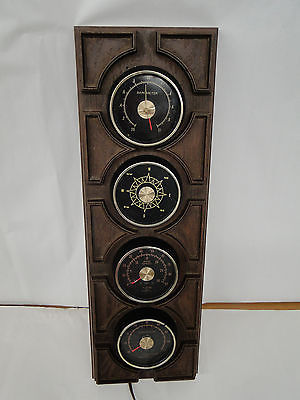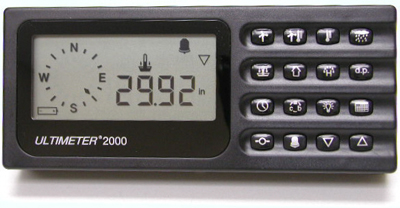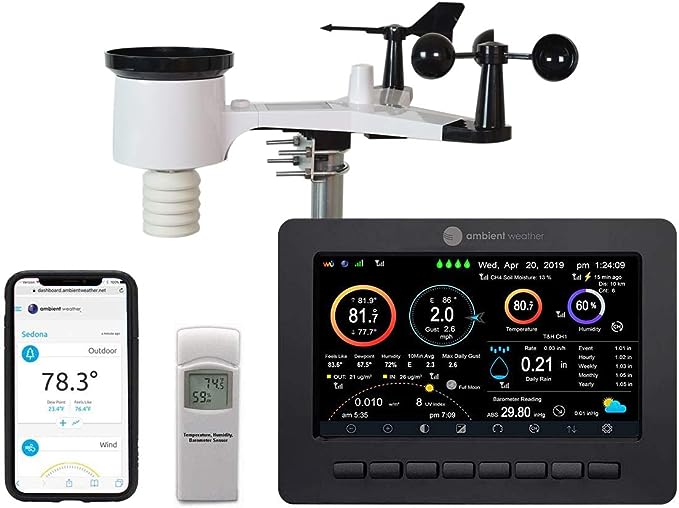 About Dave's Weather Station
About Dave's Weather Station I've been obssed with the weather for as long as I can remember. For about ten years years, my grandfather had a Heathkit ID-1910 at his house that became mine after he and grandma moved to an
apartment. The four displays gave wind speed and direction, temperature (Both indoor and outdoor via a slide switch) and barometric pressure. Unfortunately over time, the sensors and parts of the display began to fail. By this time, Heathkit had gone out of business and the Internet not available to common folk, making replacemenet parts hard to find. Thus left
me little choice but to discard the unit.
I've been obssed with the weather for as long as I can remember. For about ten years years, my grandfather had a Heathkit ID-1910 at his house that became mine after he and grandma moved to an
apartment. The four displays gave wind speed and direction, temperature (Both indoor and outdoor via a slide switch) and barometric pressure. Unfortunately over time, the sensors and parts of the display began to fail. By this time, Heathkit had gone out of business and the Internet not available to common folk, making replacemenet parts hard to find. Thus left
me little choice but to discard the unit.
 In the late 1990s, my friend Jon and I had the idea to internet enable the Peet Brothers Ultimeter 2000 at his parent's house. The unit was originally his fathers but he had passed away from cancer a few years prior. This unit had
the ability to hook up to a computer's serial port and could thus send data to a computer. Jon and I learned how to interpret the data stream and extract information similar to what the local
meteorologists were showing on TV during the six o'clock newscasts and then display it on a webpage. Becuase the unit did not automatically display items such as heat index and wind chill, we learned the formulas used by the National
Weather Service and wrote code to calculate these values. Unfortunately Jon passed away in 2014 and I do not know what happened to this weather station as it was never put back up after his mom moved to a smaller house and Jon moved
into a house of his own.
In the late 1990s, my friend Jon and I had the idea to internet enable the Peet Brothers Ultimeter 2000 at his parent's house. The unit was originally his fathers but he had passed away from cancer a few years prior. This unit had
the ability to hook up to a computer's serial port and could thus send data to a computer. Jon and I learned how to interpret the data stream and extract information similar to what the local
meteorologists were showing on TV during the six o'clock newscasts and then display it on a webpage. Becuase the unit did not automatically display items such as heat index and wind chill, we learned the formulas used by the National
Weather Service and wrote code to calculate these values. Unfortunately Jon passed away in 2014 and I do not know what happened to this weather station as it was never put back up after his mom moved to a smaller house and Jon moved
into a house of his own.
About a decade after helping Jon with his website, later while working at a big home center I bought a LaCrosse weather station. It did the same basic features as Grandpa's Heathkit one did but with a digital readout instead of analog gauges. The cheaply made outdoor sensor unit disinegrated from exposure to sunlight after only a few years and thus broke fairly easily when I moved to a different house.
A decade after that, I was walking through a Farm Supply store and saw the Accurite weather stations on an endcap. That got me thinking it was time to once again have a home weather station.
But there would be some major criteria this time around:
- Quality construction
- The need to have internet capability for remote monitoring.
- Display as much of the same information as possible that the National Weather Service's automated reporting stations do.
- Save the day's minimum and maximum values for historical purposes
 Several months of resarch led me to the Ambient Weather and their top of the line model, the WS-5000. However, when Black Friday sales began, this unit was not included so I went one step down with the WS-2000. I ordered it in mid November 2023 and installed it just before the Thanksgiving holiday. The main sensor unit is appoximately ten feet in the air. A six by six
treated deckpost remnant is sunk approximatly two and a half feet in the ground. I had originally planned on the Ambient's top of the line WS-5000 but it was not included in Ambient's annual Black Friday sale. The only difference
between the two units is the outdoor sensor array. Both use the same display unit which is where the internect connectivity originates.
Several months of resarch led me to the Ambient Weather and their top of the line model, the WS-5000. However, when Black Friday sales began, this unit was not included so I went one step down with the WS-2000. I ordered it in mid November 2023 and installed it just before the Thanksgiving holiday. The main sensor unit is appoximately ten feet in the air. A six by six
treated deckpost remnant is sunk approximatly two and a half feet in the ground. I had originally planned on the Ambient's top of the line WS-5000 but it was not included in Ambient's annual Black Friday sale. The only difference
between the two units is the outdoor sensor array. Both use the same display unit which is where the internect connectivity originates.
Knowiing for about a month that this was the display unit I was going with, I began to write the code that would generate the current conditions screen. Because the station does not directly communicate with the server driving this website, but instead sends the data to Ambient Weather's website, a roundabout method was used. Ambient Weather offers an Application Program Interface (API) to programmers who wish to use data from Ambient Weather Stations. Custom written PHP code uses this API to retrieve the data from AmbientWeather.net every five minutes. The data is extracted and stored into a MySQL database. Whenever the current conditons page is loaded, more code reads the most recent report's data and generates the page you see. Additional scripts send the weather data to WeatherUnderground, PersonalWebserver.net and the National Weather Services's Community Weather Observer Program (CWOP).